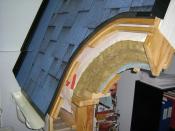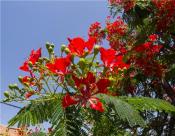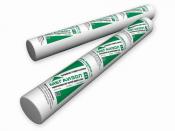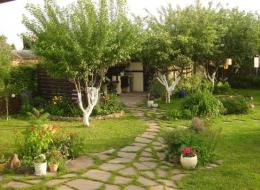Search
Login
To plant a tree, which trees to plant on a site, how to plant a tree in autumn correctly
Each of the owners of a suburban area wants to create paradise conditions for relaxation on it. At the same time, many factors will determine the degree of comfort, among which the main ones are the presence of green spaces on the site. It can be ornamental shrubs and trees or an orchard. Naturally, the question arises: what trees to plant, because each breed needs certain conditions for successful growth and development. In addition, there are popular beliefs that do not recommend planting certain types of plants on a site near the house.
Content:
- Choosing trees for a landscape garden, taking into account the climate
- When to plant trees - in autumn or spring, advantages and disadvantages
- Recommended tree planting dates in autumn video
- If the seedling has already been purchased, but failed to plant it in the fall video
- How many trees to plant in the garden
- Some useful tips
Choosing trees for a landscape garden, taking into account the climate

An important factor in the normal growth of trees is their planting in the corresponding climatic zones, for example, in the northern regions it is not recommended to plant decorative and fruit trees that are thermophilic and unstable to frost, they can die in winter from low temperatures or icing. Also, plants imported from the North will not feel comfortable in the arid southern regions.
Although there is no direct evidence that spruce and pine, walnuts, or birch trees planted near the house will bring misfortune to their owners, it can be assumed that these trees can nevertheless create some practical problems. For example, a nut has a very developed root system which, as it grows, can penetrate the scrap and destroy its foundation or damage communications laid near buildings.
coniferous

With some caution, you should treat spruces and pines growing near the house - in fact, in summer there is always an accumulation of insects near them: mosquitoes and midges, which annoy people very much. In the northern regions, it is quite the opposite - people are happy to decorate their plots with coniferous trees and enjoy the fresh aroma of the evergreen beauties exuded.
Phytoncides secreted by the plant:
- improve the functioning of the cardiovascular system,
- treat bronchial and pulmonary diseases,
- pathogens kill.
It should be borne in mind that spruce grows quickly, its height can reach 50 m, the fact that the spruce is long-lived, it can grow up to 300 years, is also pleasing. Planting of spruce is made on loamy or sandy loamy acid soil.
birch

In a small area in dry areas, birch trees should not be planted - their root system is very strong and can extract all available moisture reserves from the soil - next to the birch trees other plants will wither away. If the desire to grow a birch has won, you will have to consider the possibility of frequent and plentiful watering of the site (an adult tree can absorb up to 250 liters of water per day). An ideal option for the site would be the landing of low, for example - Karelian, they look great next to conifers, maples and bird cherry, oak and mountain ash. The most suitable time for planting a tree is early spring.
linden

It is quite unpretentious, can grow in a shaded place, but the soil must be drained. Usually linens are planted with alleys, but it also looks good as a single plant. Experienced gardeners are attracted by the opportunity to give the growing tree an original decorative shape. This is one of the trees that can bring real benefits to the site itself and improve the quality of the soil on it - humus from linden leaves enriches the earth with valuable minerals and increases its fertility. Linden is very beautiful during flowering, which usually begins in the 10th year of life.

rowan
There are also representatives of the flora who are recommended for landing on the site. These include mountain ash - a tree that in ancient times was considered a charm of the house, a symbol that gives prosperity and prosperity. It has a rather decorative appearance, thanks to the bright leaves and bunches of berries. The condition for successful cultivation will be planting in a non-swampy area, in partial shade or in the sun. The tree makes a beautiful composition with conifers and hardwoods, shrubs such as honeysuckle, rose hips and barberries.
When to plant trees - in autumn or spring, advantages and disadvantages
It is impossible to give an exact and unambiguous recommendation on the timing of planting - one should take into account the breed of trees to be planted, the conditions of a particular year, the condition of the soil, and the characteristics of the species.

Agronomists believe that it is best to plant trees in the fall, from late September to October. Plants will have enough time to adapt, they will have time to take root before the onset of frost. In addition, when choosing seedlings in the fall, you can more clearly determine their condition, make sure the health of the bark, leaves, root system. The establishment of warm weather in the spring will lead to their active development and growth.
With caution, fruit trees such as apricot, walnut, peach, and cherry should be planted in autumn — because of their heat loving nature, they hardly survive wintering. Seedlings imported from other natural zones are not recommended for autumn planting; their acclimatization is complicated.
- The main conditions for successful autumn tree planting:
- transfer the seedling to a new place with a lump of land,
- land no less than a month before the onset of frost.
The following fruit trees are recommended for fall planting:
- plums and cherry plum,
- apple tree and pear,
- mountain ash and mulberry.
As experienced gardeners note, on the trees planted in autumn, the fruits grow more juicy and large, but only those varieties that are resistant to frost are recommended to plant.
More effective will be the autumn planting of most varieties of conifers, they are easier to take root. Recommended for autumn landing:
- tsuga Canadian and thuja,
- pine and spruce,
- juniper and larch.
Most species of ornamental trees such as linden, poplar, maple, ash are also best planted in autumn. The special structure of the root system of oak and birch involves their planting in the spring. The reason is the lack of branching on the root root, spring planting allows the tree to quickly establish the process of providing nutrients and moisture.
Among the positive aspects of the autumn landing should be highlighted:
- the possibility of a wide selection of high-quality planting material with a well-formed root system,
- many sellers, as an advertisement, bring to the market the fruits obtained from trees of different varieties, the ability to assess the appearance and taste of the fruits of this variety is very important for beginner gardeners,
- lack of need for numerous watering after planting and special care, autumn rains will enrich the soil with sufficient moisture,
- until the spring, the tree will be able to heal all wounds caused by transplantation and acquire suction roots, because they will grow until the soil temperature drops to +4 C,
- opportunity to save maximum time for spring work in the garden.
When deciding which trees can be planted in autumn, the frost resistance of the varieties selected for planting must be taken into account.
Recommended tree planting dates in autumn
You can plant trees throughout almost the entire autumn, of course, if the weather is warm enough. They begin the autumn planting at the end of September, and finish - at the end of October, in the case of very warm November, the dates can be slightly extended. Acceptable periods for central Russia are from mid-September to mid-October, in the northern regions they are shorter, in the southern - longer.

In any case, the time limits are not fixed for any region, to a large extent they depend on the weather conditions of a particular year. The main guideline should be the beginning of the period of biological dormancy, i.e. end of leaf fall.
If the seedling has already been purchased, but failed to plant it in the fall
This situation develops relatively often - either the seedling of the desired variety was purchased at the very end of the season, on sales, or the temperature dropped too sharply to below zero. One should not be particularly upset; there is a way out of the situation. Just a seedling will have to be saved until spring.
There are several ways to store seedlings in the winter:
- in a cool basement with high humidity,
- by snowing,
- digging into the ground.

For storage in a basement, it will be necessary to ensure the air humidity in it is about 90% and the temperature is in the range 0 - +10 C. The roots of seedlings are best placed in an old bucket or bowl, filled with peat. Watering peat is required infrequently - once every two weeks. Thus, the young trees perfectly winter.
Snowing is a more risky method - seedlings are well packed and buried deep in the snow. It is a thick layer of snow that will not allow the temperature to drop below the standard of living acceptable for a tree.

To correctly plant the seedlings, it is advisable to adhere to the following rules:
- you should choose a suitable place, protected from the wind, dig a moat with an inclined wall on it,
- place seedlings in it, orient them from north to south, fill with soil to half the trunk, gently compact the embankment,
- protect trunks and branches from attacks by rodents,
- when frosts come - fill the trees completely, forming a mound,
- it is not recommended to use any covering materials, especially plastic wrap - in the spring, with the onset of heat, seedlings can trample.
How many trees to plant in the garden

Of course, the number of plants that can be planted on the site is determined by the size of the site itself and the dimensions of the adult tree. When creating a landscape project provides for the number and species of trees for planting. But what to do with fruit trees? If the place for the garden is large enough, then the number of trees should be calculated carefully, a reasonable approach to solving the problem will help at least partially switch to hand-grown products, therefore, it will allow you to save money.
The following trees should be included in the standard set of trees planted in the garden.

Apple trees. It makes no sense to give preference exclusively to summer varieties, especially if there is a place to store the crop in the winter. In summer, apples have a fairly low price, buying a bucket for conservation is not very expensive, it is much more important to get a good harvest of winter varieties intended for long-term storage - in winter, the cost of high-quality apples of good varieties is quite high. From here, one can recommend planting summer, autumn and winter apple trees in the following proportion: to plant 2 trees of autumn varieties and 3 trees of winter varieties for each tree of the summer variety. If there is no basement, then winter apple trees should be planted about half as much - in indoor conditions the apples will have a shorter shelf life. For a small family of 3-5 people, it will be enough to plant a couple of apple varieties of summer varieties with different ripening periods, 3-4 trees with autumn varieties, 5-6 trees of winter varieties.

PearsIt is advisable to plant two of them, this will improve the pollination of trees, which will help increase productivity. Again, you should pay attention to both the summer variety and the autumn-winter variety.

Cherries and Cherries. It is also recommended to plant a pair of trees of each species.

Cherry plum and plums. It will be enough to plant 2 trees of different ripening varieties.

Currants and gooseberries. It is necessary to plant several bushes of currant in a row, otherwise there will be no harvest. Currants can be stored frozen and grated with sugar. Having stocked berries, you can provide the whole family with a delicious vitamin product for the whole year. Gooseberries are better to choose non-studded varieties that are resistant to all kinds of diseases.

Unforgettably raspberries and blackberries. It is better to plant repairing varieties, but their ripening dates should end before frost.

Honeysuckle. This shrub gives you the opportunity to get the earliest berries. It is advisable to plant at least two of its bushes of different varieties.
Of course, the indicated number of plants in the garden is approximate, each garden owner can adjust it depending on their preferences.
Some useful tips
- Experience shows that for planting in the middle lane, in the Urals and in Siberia, it is best to choose zoned or winter-hardy varieties, they are adapted to survive in harsh climatic conditions. In these natural zones, pears, apple trees, and mulberries, which are selected in Siberia and the Urals, grow and bear fruit.
- For the southern regions, the autumn version of tree planting is more acceptable - moist warm autumn lasts a long time, creating excellent conditions for planting seedlings, spring often changes early onset in too hot summers.
- If the seedlings are dug too early, then their young shoots will remain unripe, this significantly increases the risk of frostbite.
- You should not buy beautiful seedlings with not fallen leaves - such instances are usually not ripe, overdried, because most of the moisture received by the plant is lost through the leaf plate.

It should not be forgotten that nature will always help her offspring-sapling to cope with all the problems and survive, the task of the gardener is to give her healthy, mature trees with a strong root system in her care. If you know how to plant a tree correctly, then it will grow quickly, regardless of when it will be planted, to please us with lush greenery and bright fruits.





